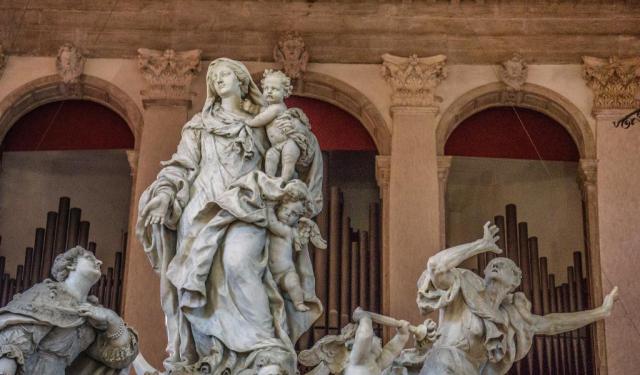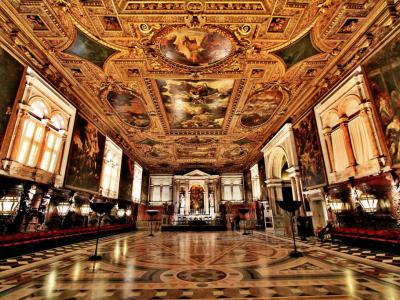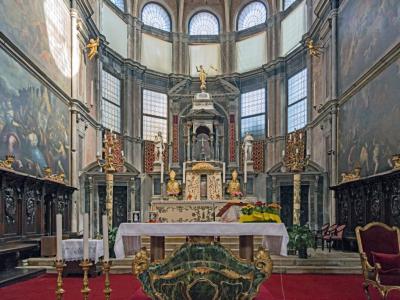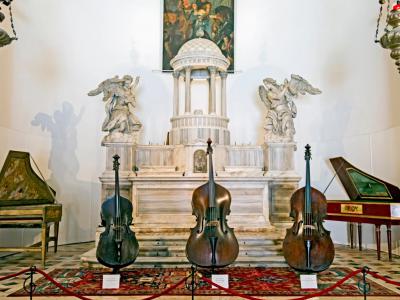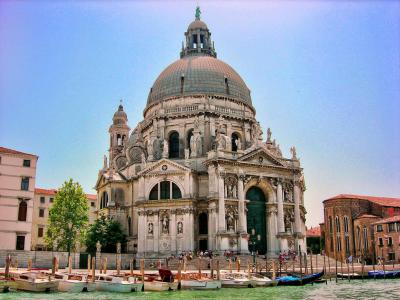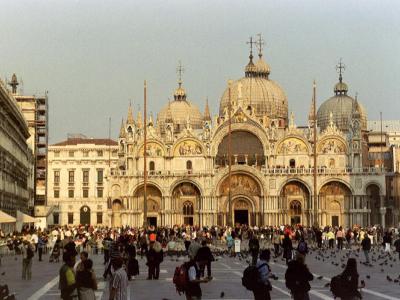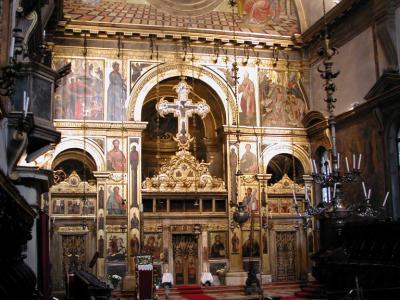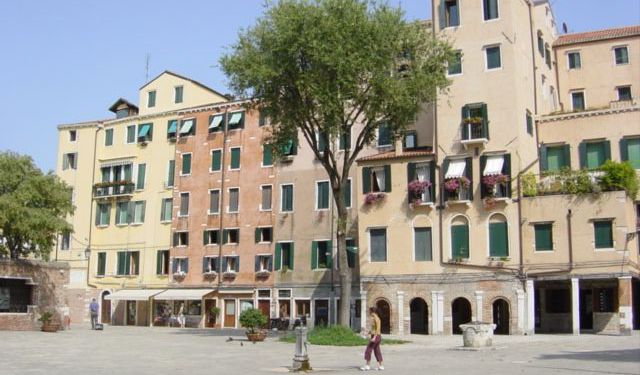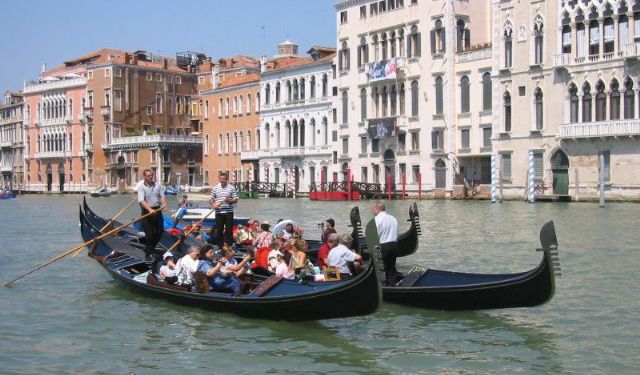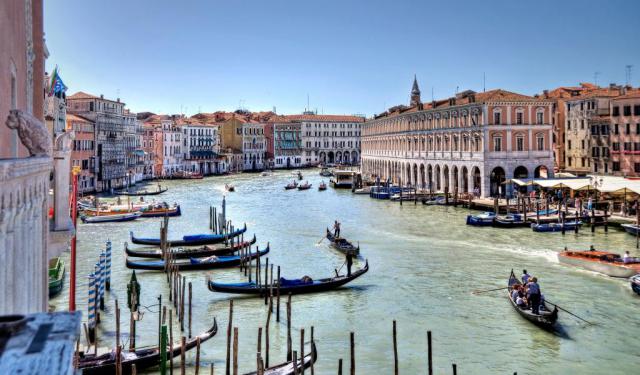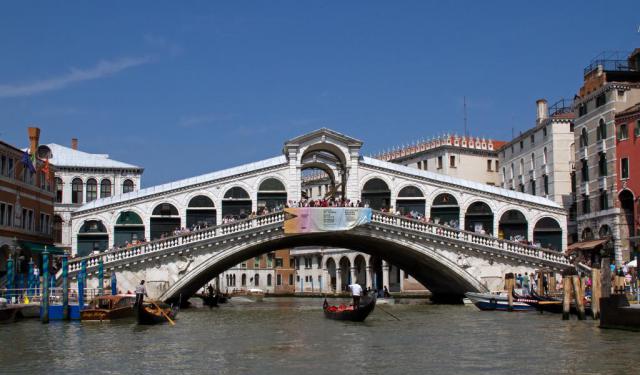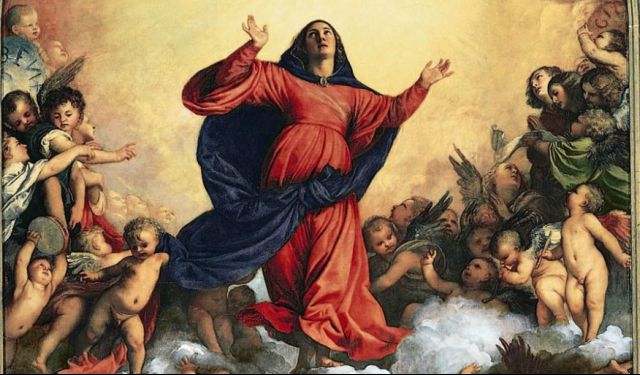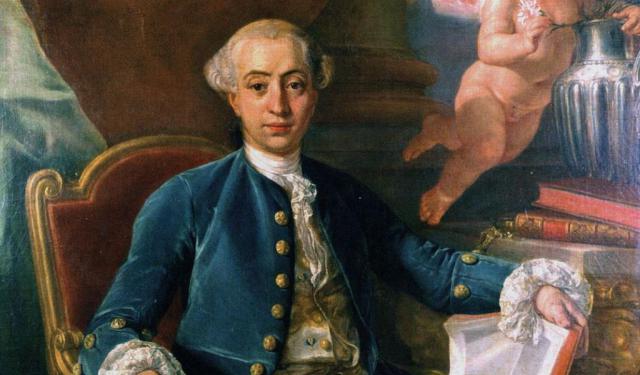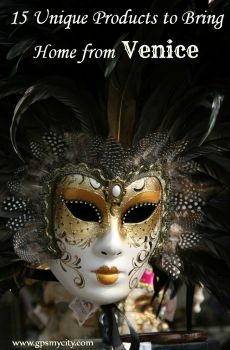Venice's Hidden Art Treasures (Self Guided), Venice
Among the first things springing to mind when talking about Venice, apart from the canals and gondolas, of course, is Art and Architecture. Indeed, Venice is one of the few cities in the world where Art and Architecture have merged in a stunning multiplicity of forms. The city is even renowned for its unique (Venetian) pictorial school famed by the likes of Tintoretto, Titian, Veronese, Castagno and other grands, whose influence had given rise to a plethora of other remarkable painters like Damasceno, El Greco and more.
Home to some of the world’s most iconic sights, the incredible floating settlement in the middle of the Venetian Lagoon can hardly leave anyone indifferent. The ancient artistic legacy and watery beauty of Venice has long attracted tourists (nowadays up to 20 million per year) from all over the world, which, particularly in summer, can get the city really clogged up with them. Even to an experienced traveler, Venice's enormous art scene, going back 1600 years, can be mind-boggling and expensive exercise to indulge in.
Yet, although for the most part you will have to pay handsomely to explore the visual side of Venice, there’s a lot more to this city, in terms of hidden art gems, than meets the eye. An ancient city with a mysterious history, Venice is packed with secret locations and unbeaten paths waiting to be uncovered, if you know where to look. And it won’t cost you a penny!
Here are some of the lesser-known attractions in Venice housing amazing works of art that are well worth seeking out:
Scuola Grande di San Rocco – the former religious confraternity, whose ornate ceiling is an astonishing masterpiece by Tintoretto;
Church of Santa Maria dei Carmini – home to one of the early works by Tintoretto (the Presentation of Jesus at the Temple) still extant;
Santa Maria della Salute – Venice's most famous church by image, emblematic of the city, with a small art gallery in its sacristy;
Saint George of the Greeks' Church and Museum of Icons – home to Damasceno frescoes and a wealth of ancient Greek-Byzantine icons and Orthodox sacred vestments.
If you want to beat the crowds in Venice and enjoy some of its hidden yet fascinating gems for free, get off the beaten track and lose yourself without getting lost on this self-guided walking tour!
Home to some of the world’s most iconic sights, the incredible floating settlement in the middle of the Venetian Lagoon can hardly leave anyone indifferent. The ancient artistic legacy and watery beauty of Venice has long attracted tourists (nowadays up to 20 million per year) from all over the world, which, particularly in summer, can get the city really clogged up with them. Even to an experienced traveler, Venice's enormous art scene, going back 1600 years, can be mind-boggling and expensive exercise to indulge in.
Yet, although for the most part you will have to pay handsomely to explore the visual side of Venice, there’s a lot more to this city, in terms of hidden art gems, than meets the eye. An ancient city with a mysterious history, Venice is packed with secret locations and unbeaten paths waiting to be uncovered, if you know where to look. And it won’t cost you a penny!
Here are some of the lesser-known attractions in Venice housing amazing works of art that are well worth seeking out:
Scuola Grande di San Rocco – the former religious confraternity, whose ornate ceiling is an astonishing masterpiece by Tintoretto;
Church of Santa Maria dei Carmini – home to one of the early works by Tintoretto (the Presentation of Jesus at the Temple) still extant;
Santa Maria della Salute – Venice's most famous church by image, emblematic of the city, with a small art gallery in its sacristy;
Saint George of the Greeks' Church and Museum of Icons – home to Damasceno frescoes and a wealth of ancient Greek-Byzantine icons and Orthodox sacred vestments.
If you want to beat the crowds in Venice and enjoy some of its hidden yet fascinating gems for free, get off the beaten track and lose yourself without getting lost on this self-guided walking tour!
How it works: Download the app "GPSmyCity: Walks in 1K+ Cities" from Apple App Store or Google Play Store to your mobile phone or tablet. The app turns your mobile device into a personal tour guide and its built-in GPS navigation functions guide you from one tour stop to next. The app works offline, so no data plan is needed when traveling abroad.
Venice's Hidden Art Treasures Map
Guide Name: Venice's Hidden Art Treasures
Guide Location: Italy » Venice (See other walking tours in Venice)
Guide Type: Self-guided Walking Tour (Sightseeing)
# of Attractions: 6
Tour Duration: 2 Hour(s)
Travel Distance: 3.6 Km or 2.2 Miles
Author: DanaOffice
Sight(s) Featured in This Guide:
Guide Location: Italy » Venice (See other walking tours in Venice)
Guide Type: Self-guided Walking Tour (Sightseeing)
# of Attractions: 6
Tour Duration: 2 Hour(s)
Travel Distance: 3.6 Km or 2.2 Miles
Author: DanaOffice
Sight(s) Featured in This Guide:
- Scuola Grande di San Rocco (Great School of St. Roch)
- Chiesa di Santa Maria dei Carmini (Church of St. Mary of the Carmine)
- Chiesa di San Maurizio: Museo della Musica (Museum of Musical Instruments)
- Basilica di Santa Maria della Salute (Basilica of Our Lady of Good Health)
- Basilica di San Marco (St. Mark's Basilica)
- Chiesa di San Giorgio dei Greci & Museo delle Icone (Museum of Icons)
1) Scuola Grande di San Rocco (Great School of St. Roch) (must see)
The religious fraternity ("scuola") of Saint Roch was set up in Venice in 1478. Seven years later, the saint's remains were brought from Germany, resulting in a surge of donations so great that in 1489, the fraternity attained the status of a "Scuola Grande". In 1527, the city was struck by a plague outbreak, causing the scuola's revenue to skyrocket as people desperately sought Saint Roch's protection from the disease. The funds generated eventually financed the construction of the current building, complete with the remarkable paintings inside.
Indeed, no other Venetian fraternity is as lavishly decorated as this one. The artist responsible for its decoration is Venice's own 16th-century painter, Tintoretto. Born Jacopo Robusti, he acquired his nickname, which means "little dyer" or "dyer's boy", due to his father's profession as a dyer ("tintore"). Also known as Il Furioso ("The Furious") for his phenomenal energy in painting, Tintoretto was both admired and criticized by his contemporaries for the unprecedented boldness of his brushwork and his incredible speed. Nonetheless, it took him three decades to complete this project, starting at the age of 46 and continuing until his death in 1594 at the age of 76.
During this time, Tintoretto created over 50 epic canvases for the walls and ceilings of the Scuola Grande, earning it high praise from critics as "one of the three most precious buildings in Italy" due to its overwhelming impact. While the Tintoretto cycle begins with the "Annunciation" in the lower room, to truly appreciate his artistic progression, it is best to start in the smaller room on the upper floor, known as the Sala dell'Albergo, which houses the "Crucifixion" painting, showcasing the full magnitude of Tintoretto's mastery.
Other notable highlights include the New Testament scenes in the main upper hall, which defy conventions of perspective, lighting, and color-a testament to Tintoretto's relentless inventiveness that has few parallels in Western art. Despite being in his late 60s when he painted these scenes, they are considered some of his finest creations.
Why You Should Visit:
Rarely busy or crowded, offering a peaceful oasis of culture and Venetian history.
Photos do not do justice to the overwhelming experience of seeing it in person.
Tip:
Don't forget to pick up an audio guide since there are no descriptions available.
Dress warmly as it can get quite cold inside, and don't forget to bring your camera.
Take advantage of the mirrors in the chapter room to study the ceiling art without straining your neck.
Indeed, no other Venetian fraternity is as lavishly decorated as this one. The artist responsible for its decoration is Venice's own 16th-century painter, Tintoretto. Born Jacopo Robusti, he acquired his nickname, which means "little dyer" or "dyer's boy", due to his father's profession as a dyer ("tintore"). Also known as Il Furioso ("The Furious") for his phenomenal energy in painting, Tintoretto was both admired and criticized by his contemporaries for the unprecedented boldness of his brushwork and his incredible speed. Nonetheless, it took him three decades to complete this project, starting at the age of 46 and continuing until his death in 1594 at the age of 76.
During this time, Tintoretto created over 50 epic canvases for the walls and ceilings of the Scuola Grande, earning it high praise from critics as "one of the three most precious buildings in Italy" due to its overwhelming impact. While the Tintoretto cycle begins with the "Annunciation" in the lower room, to truly appreciate his artistic progression, it is best to start in the smaller room on the upper floor, known as the Sala dell'Albergo, which houses the "Crucifixion" painting, showcasing the full magnitude of Tintoretto's mastery.
Other notable highlights include the New Testament scenes in the main upper hall, which defy conventions of perspective, lighting, and color-a testament to Tintoretto's relentless inventiveness that has few parallels in Western art. Despite being in his late 60s when he painted these scenes, they are considered some of his finest creations.
Why You Should Visit:
Rarely busy or crowded, offering a peaceful oasis of culture and Venetian history.
Photos do not do justice to the overwhelming experience of seeing it in person.
Tip:
Don't forget to pick up an audio guide since there are no descriptions available.
Dress warmly as it can get quite cold inside, and don't forget to bring your camera.
Take advantage of the mirrors in the chapter room to study the ceiling art without straining your neck.
2) Chiesa di Santa Maria dei Carmini (Church of St. Mary of the Carmine)
Also known as Santa Maria dei Carmelo, this church was constructed in the 14th century but has undergone significant modifications over time. The most notable external feature is the tall bell tower, which was skillfully straightened in 1688 to correct its precarious lean. The interior is spacious, solemn, and lavishly adorned, with gilded statues embellishing the nave, and a series of paintings depicting the history of the Carmelite Order.
The church houses two noteworthy paintings in its side altars. Cima da Conegliano's "Adoration of the Shepherds" (circa 1509) can be found in the second altar on the right (don't forget to bring coins for the light meter). In the second altar on the left, there is Lorenzo Lotto's "Saint Nicholas of Bari with Saints Lucy and John the Baptist" (circa 1529). This artwork showcases the artist's religious devotion and his appreciation for nature. Within the highly detailed landscape on the right side, you can spot a miniature depiction of Saint George slaying the dragon. Adjacent to it is Paolo Veronese's "Holy Family".
The church houses two noteworthy paintings in its side altars. Cima da Conegliano's "Adoration of the Shepherds" (circa 1509) can be found in the second altar on the right (don't forget to bring coins for the light meter). In the second altar on the left, there is Lorenzo Lotto's "Saint Nicholas of Bari with Saints Lucy and John the Baptist" (circa 1529). This artwork showcases the artist's religious devotion and his appreciation for nature. Within the highly detailed landscape on the right side, you can spot a miniature depiction of Saint George slaying the dragon. Adjacent to it is Paolo Veronese's "Holy Family".
3) Chiesa di San Maurizio: Museo della Musica (Museum of Musical Instruments)
Originally, there had been a place of worship on this site since as early as 699 AD. The current church, which is no longer used for religious purposes, was constructed in 1806. Designed in the Neoclassical style, it was the creation of architect Giovanni Antonio Selva, renowned for his work on the famous local opera house, The Phoenix ("La Fenice").
Now occupying the space is the Museum of Musical Instruments, one of the few free museums in the city. The exhibits, all located in a single room, showcase a collection of antique musical instruments, documents, and artifacts related to the musical personalities of Baroque Venice. Among them are renowned figures such as Antonio Vivaldi, the world-famous virtuoso violinist and composer born in Venice in 1678; the Amati family, esteemed violin makers, including Nicolò Amati, who taught Antonio Stradivari and Andrea Guarneri; Giovanni Battista Guadagnini, an esteemed Italian luthier considered one of the greatest craftsmen of string instruments in history, following Antonio Stradivari and Giuseppe Guarneri ("del Gesù"); and Francesco and Matteo Goffriller, master makers of violins, violas, and cellos in the Venetian school, among others.
The collection consists of around 150 instruments dating from the 16th to the 19th centuries, and includes nearly 40 violins, 20 violas, several cellos and double basses, as well as approximately 10 mandolins. Additionally, visitors can explore historical flutes, harps, and other intriguing musical instruments, such as the 17th-century psalterium that was later transformed into a zither and dulcimer.
Now occupying the space is the Museum of Musical Instruments, one of the few free museums in the city. The exhibits, all located in a single room, showcase a collection of antique musical instruments, documents, and artifacts related to the musical personalities of Baroque Venice. Among them are renowned figures such as Antonio Vivaldi, the world-famous virtuoso violinist and composer born in Venice in 1678; the Amati family, esteemed violin makers, including Nicolò Amati, who taught Antonio Stradivari and Andrea Guarneri; Giovanni Battista Guadagnini, an esteemed Italian luthier considered one of the greatest craftsmen of string instruments in history, following Antonio Stradivari and Giuseppe Guarneri ("del Gesù"); and Francesco and Matteo Goffriller, master makers of violins, violas, and cellos in the Venetian school, among others.
The collection consists of around 150 instruments dating from the 16th to the 19th centuries, and includes nearly 40 violins, 20 violas, several cellos and double basses, as well as approximately 10 mandolins. Additionally, visitors can explore historical flutes, harps, and other intriguing musical instruments, such as the 17th-century psalterium that was later transformed into a zither and dulcimer.
4) Basilica di Santa Maria della Salute (Basilica of Our Lady of Good Health) (must see)
While San Marco may hold the title of Venice's most famous church in name, it is Santa Maria della Salute that claims the city's most iconic image and silhouette. Affectionately known as La Salute, this grand historical church is largely recognized as the pinnacle of the city's Baroque movement.
La Salute is the youngest among the so-called "plague churches". Back in the early 1630s, Venice was ravaged by a plague that claimed the lives of nearly 100,000 people, roughly one-third of the lagoon's population. In gratitude for deliverance from this calamity, the Republic of Venice made a vow to construct and dedicate a church to Our Lady of Good Health (or Deliverance), hence the name "Salute" in Italian. Resting on a foundation of over 100,000 wooden piles, the church was designed in the fashionable Baroque style of the time by Baldassare Longhena, who devoted half a century to this grand project and lived long enough to witness its completion in 1681.
The dome of La Salute became an important addition to the Venetian skyline and soon became emblematic of the city, inspiring painters both local, such as Canaletto and Francesco Guardi, and foreign, such as J. M. W. Turner, Claude Monet and John Singer Sargent.
The basilica itself offers an intriguing visit. Its sacristy houses a small art gallery featuring notable works such as Tintoretto's "Marriage Feast of Cana" and allegorical ceiling paintings by Titian, the eminent figure of the 16th-century Venetian school. These include masterpieces like "David and Goliath", "Abraham and Isaac", "Cain and Abel", as well as eight circular paintings depicting the "Doctors of the Church and the Evangelists". Also by Titian are "The Descent of the Holy Ghost", located in the third altar to the left of the entrance, and the altarpiece of the sacristy portraying "Saint Mark Enthroned with Saints Cosmas, Damian, Sebastian, and Roch."
A highly symbolic statuary group called "The Queen of Heaven expelling the Plague" (1670) by the Flemish sculptor Josse de Corte stands out at the high altar. This theatrical Baroque masterpiece depicts the Virgin (portrayed as a kneeling young woman) and Child rescuing Venice from the clutches of the plague (portrayed as an old woman).
Entrance to the Basilica is always free during the opening hours, although a ticket is required to enter the main sacristy (museum). It is advisable to secure your tickets in advance to avoid long queues. Once inside, you can indulge in a unique view of the adjoining square from the balcony and, if fortunate, attend a 30-minute organ recital following the service. Be sure to check the events program in advance for schedules and enjoy this special experience.
Tip:
As there are limited cafes in the vicinity, it is advisable to bring a drink with you during your visit.
La Salute is the youngest among the so-called "plague churches". Back in the early 1630s, Venice was ravaged by a plague that claimed the lives of nearly 100,000 people, roughly one-third of the lagoon's population. In gratitude for deliverance from this calamity, the Republic of Venice made a vow to construct and dedicate a church to Our Lady of Good Health (or Deliverance), hence the name "Salute" in Italian. Resting on a foundation of over 100,000 wooden piles, the church was designed in the fashionable Baroque style of the time by Baldassare Longhena, who devoted half a century to this grand project and lived long enough to witness its completion in 1681.
The dome of La Salute became an important addition to the Venetian skyline and soon became emblematic of the city, inspiring painters both local, such as Canaletto and Francesco Guardi, and foreign, such as J. M. W. Turner, Claude Monet and John Singer Sargent.
The basilica itself offers an intriguing visit. Its sacristy houses a small art gallery featuring notable works such as Tintoretto's "Marriage Feast of Cana" and allegorical ceiling paintings by Titian, the eminent figure of the 16th-century Venetian school. These include masterpieces like "David and Goliath", "Abraham and Isaac", "Cain and Abel", as well as eight circular paintings depicting the "Doctors of the Church and the Evangelists". Also by Titian are "The Descent of the Holy Ghost", located in the third altar to the left of the entrance, and the altarpiece of the sacristy portraying "Saint Mark Enthroned with Saints Cosmas, Damian, Sebastian, and Roch."
A highly symbolic statuary group called "The Queen of Heaven expelling the Plague" (1670) by the Flemish sculptor Josse de Corte stands out at the high altar. This theatrical Baroque masterpiece depicts the Virgin (portrayed as a kneeling young woman) and Child rescuing Venice from the clutches of the plague (portrayed as an old woman).
Entrance to the Basilica is always free during the opening hours, although a ticket is required to enter the main sacristy (museum). It is advisable to secure your tickets in advance to avoid long queues. Once inside, you can indulge in a unique view of the adjoining square from the balcony and, if fortunate, attend a 30-minute organ recital following the service. Be sure to check the events program in advance for schedules and enjoy this special experience.
Tip:
As there are limited cafes in the vicinity, it is advisable to bring a drink with you during your visit.
5) Basilica di San Marco (St. Mark's Basilica) (must see)
By far, the main draw for tourists visiting Venice is Saint Mark's Basilica. Its construction dates back to 832 AD when it was built to house the remains of Saint Mark, the city's patron saint. Legend has it that the holy man's body was brought from Alexandria, Egypt, hidden in barrels of pork meat, which the Venetian merchants believed the Muslim guards would never touch. Upon arrival in the lagoon, Saint Mark was said to be greeted by an angel who proclaimed that his body would find rest in that place. This legend has inspired numerous works of art throughout the centuries.
Two hundred years later, a magnificent temple was erected on the foundations of an earlier church and consecrated when Saint Mark's body was laid to rest beneath the high altar. The new basilica was designed after the renowned Church of the Apostles in Constantinople. To enhance its splendor, the structure was adorned with marble and mosaics depicting scenes from the Old and New Testaments, as well as the lives of Christ, the Virgin Mary, and Saint Mark himself.
Over time, many of the mosaics were retouched or replaced as artistic tastes evolved and damaged mosaics needed restoration. As a result, the current mosaics represent a span of 800 years of artistic styles. Some mosaics reflect traditional Byzantine representations and stand as masterpieces of medieval art, while others were based on preparatory drawings by renowned Renaissance artists from Venice and Florence, such as Paolo Veronese, Tintoretto, Titian, Paolo Uccello, and Andrea del Castagno.
Andrea del Castagno, active at San Marco in the mid-15th century, introduced a sense of perspective largely achieved with architectural settings. One of his notable contributions is the mosaic in the Mascoli Chapel, depicting the "Dormition of the Virgin". Tintoretto, on the other hand, created the mosaic in the central nave depicting the "Presentation of Jesus at the Temple" in the 16th century, while Titian designed and executed the mosaic decoration of the Sacristy vault between 1524 and 1530, depicting Old Testament prophets.
Inside the basilica, there are additional spots that can be visited for a separate fee, including the Golden Altar, the Museum, the Treasury, and the Crypt. It is highly recommended to pay for access to the first level, offering elevated views of the interior and the square outside. Alternatively, consider taking a night tour when the basilica is closed to the public, allowing you to have the entire place to yourself.
Entry to the basilica is free, but for a small fee, you can skip the line and book a time slot.
Why You Should Visit:
To witness the exceptional blend of Byzantine and Western art, showcased through the grandeur of the mosaics and the richness of the 'treasure room', offering insights into the immense power and wealth of Venice during its golden era.
Tip:
The best time to visit is around midday when the golden mosaics adorning the vaults, walls, and cupolas are illuminated and at their most spectacular. The lights are only turned on for a limited time (11:30am-12:30pm), so be sure to plan your visit accordingly to witness and appreciate the mosaics at their best.
Two hundred years later, a magnificent temple was erected on the foundations of an earlier church and consecrated when Saint Mark's body was laid to rest beneath the high altar. The new basilica was designed after the renowned Church of the Apostles in Constantinople. To enhance its splendor, the structure was adorned with marble and mosaics depicting scenes from the Old and New Testaments, as well as the lives of Christ, the Virgin Mary, and Saint Mark himself.
Over time, many of the mosaics were retouched or replaced as artistic tastes evolved and damaged mosaics needed restoration. As a result, the current mosaics represent a span of 800 years of artistic styles. Some mosaics reflect traditional Byzantine representations and stand as masterpieces of medieval art, while others were based on preparatory drawings by renowned Renaissance artists from Venice and Florence, such as Paolo Veronese, Tintoretto, Titian, Paolo Uccello, and Andrea del Castagno.
Andrea del Castagno, active at San Marco in the mid-15th century, introduced a sense of perspective largely achieved with architectural settings. One of his notable contributions is the mosaic in the Mascoli Chapel, depicting the "Dormition of the Virgin". Tintoretto, on the other hand, created the mosaic in the central nave depicting the "Presentation of Jesus at the Temple" in the 16th century, while Titian designed and executed the mosaic decoration of the Sacristy vault between 1524 and 1530, depicting Old Testament prophets.
Inside the basilica, there are additional spots that can be visited for a separate fee, including the Golden Altar, the Museum, the Treasury, and the Crypt. It is highly recommended to pay for access to the first level, offering elevated views of the interior and the square outside. Alternatively, consider taking a night tour when the basilica is closed to the public, allowing you to have the entire place to yourself.
Entry to the basilica is free, but for a small fee, you can skip the line and book a time slot.
Why You Should Visit:
To witness the exceptional blend of Byzantine and Western art, showcased through the grandeur of the mosaics and the richness of the 'treasure room', offering insights into the immense power and wealth of Venice during its golden era.
Tip:
The best time to visit is around midday when the golden mosaics adorning the vaults, walls, and cupolas are illuminated and at their most spectacular. The lights are only turned on for a limited time (11:30am-12:30pm), so be sure to plan your visit accordingly to witness and appreciate the mosaics at their best.
6) Chiesa di San Giorgio dei Greci & Museo delle Icone (Museum of Icons)
The standout feature of this 16th-century Greek church is its leaning campanile, which appears as though it could tumble into the Rio dei Greci at any moment. Inside, you will find the "matroneo", a gallery where, following Greek Orthodox tradition, women would sit separately from the men. Take note of the iconostasis, a screen that separates the sanctuary from the nave, adorned with marble decorations and paintings by Michele Damasceno, a prominent artist from the 16th-century Cretan school. Despite immigrating to Italy and being influenced by Venetian painters like Tintoretto and Paolo Veronese, Damasceno remained strongly rooted in the Greek-Byzantine style. His paintings depict various saints, and on the architrave, you will find depictions of the Twelve Feasts.
Close by, the Scuola di San Nicolò dei Greci, redesigned in 1678, now serves as the Museum of Icons ("Museo delle Icone") of the Hellenic Institute, dedicated to Greek-Byzantine icons and Orthodox sacred vestments. It boasts a collection of 300 icons and numerous manuscripts, including a notable copy of the Alexander Romance, a narrative detailing the life and adventures of Alexander the Great.
Museum
Close by, the Scuola di San Nicolò dei Greci, redesigned in 1678, now serves as the Museum of Icons ("Museo delle Icone") of the Hellenic Institute, dedicated to Greek-Byzantine icons and Orthodox sacred vestments. It boasts a collection of 300 icons and numerous manuscripts, including a notable copy of the Alexander Romance, a narrative detailing the life and adventures of Alexander the Great.
Museum
Walking Tours in Venice, Italy
Create Your Own Walk in Venice
Creating your own self-guided walk in Venice is easy and fun. Choose the city attractions that you want to see and a walk route map will be created just for you. You can even set your hotel as the start point of the walk.
Jewish Ghetto Tour
Founded in 1516, the Jewish Ghetto in Venice was the oldest of its kind in all Europe. At the time, Venice received order from the Pope to expel all Jews from the city, but the Venetian government opted to lock them onto a small island in the district of Cannaregio. Since then this small area has been the center of Jewish life in Venice, with buildings rising vertically to accommodate the rising... view more
Tour Duration: 1 Hour(s)
Travel Distance: 0.4 Km or 0.2 Miles
Tour Duration: 1 Hour(s)
Travel Distance: 0.4 Km or 0.2 Miles
Grand Canal Walking Tour
The main waterway in Venice, Grand Canal snakes in an "S" shape through the center of the city, dividing its main districts. On both sides of this thoroughfare are the most beautiful buildings dating from the 12th to the 18th centuries that tell the story of a thousand years of Venetian splendor. While one can view the architectural parade from water buses, our self-guided walking tour... view more
Tour Duration: 3 Hour(s)
Travel Distance: 5.2 Km or 3.2 Miles
Tour Duration: 3 Hour(s)
Travel Distance: 5.2 Km or 3.2 Miles
Venice Introduction Walking Tour
Although most experts agree that the Venetian lagoon emerged nearly 6,000 years ago, the area of today's Venice remained mostly uninhabited, except for a small population of fishermen, up until the 5th century AD when the hordes of Gothic barbarians, looting their way into Rome, drove many a people away from their homes on the mainland to take refuge on the coastal Venetian islands.
Those... view more
Tour Duration: 3 Hour(s)
Travel Distance: 4.1 Km or 2.5 Miles
Those... view more
Tour Duration: 3 Hour(s)
Travel Distance: 4.1 Km or 2.5 Miles
Around Rialto Bridge
Having first appeared in documents that date back to the 9th century, the Rialto district was almost completely destroyed by fire in 1514, with the church of San Giacomo as the only structure left standing. Today, it is a busy urban village with a daily vegetable and fish market, several historic sights, plus a wide variety of shopping and dining options. Our self-guided walking tour takes you to... view more
Tour Duration: 1 Hour(s)
Travel Distance: 0.4 Km or 0.2 Miles
Tour Duration: 1 Hour(s)
Travel Distance: 0.4 Km or 0.2 Miles
Titian's Paintings Walk
One of the greatest painters of all time, Tiziano Vecelli – better known as Titian – was a pioneering figure of the Venetian school of Italian Renaissance painting. His career was successful from the start, and he became sought after by patrons, initially from Venice and its possessions, then joined by the north Italian princes, and finally the Habsburgs and papacy.
Equally adept with... view more
Tour Duration: 2 Hour(s)
Travel Distance: 3.6 Km or 2.2 Miles
Equally adept with... view more
Tour Duration: 2 Hour(s)
Travel Distance: 3.6 Km or 2.2 Miles
Casanova's Venice
One of Venice's most famous personalities, Giacomo Casanova is remembered today as a womanizer, but was much more than that. Born in a family of theater actors in 1725, he came through as highly intellectual and very sharp from his very childhood, having become in his time an erudite scholar, a diplomat and spy, and a metropolitan ‘avant la lettre’, who frequented the high society and... view more
Tour Duration: 2 Hour(s)
Travel Distance: 4.5 Km or 2.8 Miles
Tour Duration: 2 Hour(s)
Travel Distance: 4.5 Km or 2.8 Miles
Useful Travel Guides for Planning Your Trip
15 Distinctively Italian Things to Buy in Venice
Venice has been a tourist mecca for over a century now, with millions of visitors flocking in every year to see this unique place on the face of the Earth. Many, if not all, of these people seek to obtain something memorable as a token of their stay in this city. By far, not all of them know which...
The Most Popular Cities
/ view all
